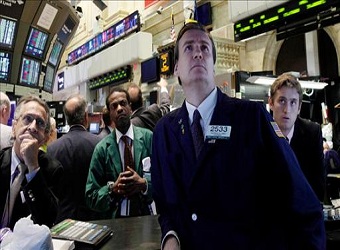U.S. stocks closed down on Friday- the last day of the first quarter and of the month- as investors digested a slew of economic data.
The Dow Jones industrial average fell about 65 points, with Goldman Sachs and Exxon Mobil contributing the most losses. The S&P 500 slipped 0.23 percent, with financials lagging.
The Nasdaq composite closed just below breakeven.
The three major U.S. indexes posted quarterly gains of at least 4.6 percent. The Nasdaq also recorded its best quarterly performance since 2013 as tech stocks rose more than 12 percent in the period.
“It’s kind of surprising how resilient markets have been, in part because people are seeing the reality of Washington,” said Bruce McCain, chief investment strategist at Key Private Bank, noting that market participants are realising the Trump administration’s pro-growth policies may not come as soon as they thought.
“The fact that the market has held in here is a testament to how embedded that hope is in the American psyche. The question is whether that will continue,” he said.
Stocks rallied in the first quarter largely on expectations that President Donald Trump’s administration will be able to move forward with tax reform, deregulation and infrastructure spending policies, all of which are considered pro-growth.
However, after a tumultuous start, the administration may be forced to push back some of these policy proposals. Trump’s presidency took a hit last week when a Republican-led bill what would have replaced Obamacare was defeated.
The first-quarter rally slowed down this month, with the S&P closing flat for March, while the Dow lost 0.72 percent and the Nasdaq gained 1.48 percent.
Stephen Wood, chief market strategist at Russell Investments, said investors will need to be mindful of the high valuations in stocks moving forward.
“Short-term momentum and sentiment can be very powerful but over the long-term valuations matter,” he said.
However, March also marked the eighth anniversary of the current bull market, one which is not in danger right now, according to Michael Arone, chief investment strategist at State Street Global Advisors.
“There are three things I’m looking for to see whether the bull market is ending,” a pick-up in the number of corrections, rising real interest rates and wider spreads in the credit market, Arone said. “None of those are flashing red, probably not even yellow at this point.
In economic news, personal income rose 0.4 percent in February, in line with expectations, while consumer spending rose 0.1 percent, below an expected increase of 0.2 percent.
The PCE price index, an indicator of inflation, rose 2.1 percent year over year, while core PCE increased 1.8 percent from last year.
“As the Fed loves the PCE instead of the CPI, the nearing of their two percent core inflation rate coincides with their determination of hiking at least 3 times this year.
As there are eight meetings, it’s still pretty damn gradual,” said Peter Boockvar, chief market analyst at The Lindsey Group, in a note.
The Chicago manufacturing PMI rose to 57.7 this month from 57.4 in February. Consumer sentiment hit 96.9 versus an expected read of 97.6.
U.S. Treasurys held mostly higher, with the two-year note yield near 1.26 percent and the benchmark 10-year yield around 2.39 percent.
The U.S. dollar traded marginally higher against a basket of currencies, with the euro near $1.067 and the yen around 111.3.
Overseas, European equities closed slightly higher, with the pan-European Stoxx 600 index rising 0.18 percent. The index also ended the quarter 5.46 percent higher.
In Asia, the Shanghai composite rose 0.38 percent and capped the first quarter with a gain of 3.83 percent.
The Dow Jones industrial average fell 65.27 points, or 0.31 percent, to close at 20,663.22, with Exxon Mobil leading decliners and IBM the top advancer.
The S&P 500 declined 5.34 points, or 0.23 percent, to end at 2,362.72, with financials leading eight sectors lower and real estate outperforming.
The Nasdaq slipped 2.61 points, or 0.04 percent, to close at 5,911.74.
About nine stocks advanced for every five decliners at the New York Stock Exchange, with an exchange volume of 982.64 million and a composite volume of 3.317 billion at the close.
The CBOE Volatility Index (VIX), widely considered the best gauge of fear in the market, traded near 12.3.
Source: CNBC


